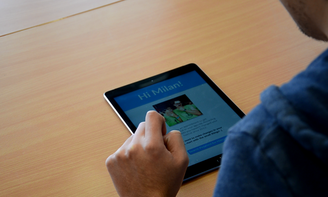Design and Research Processes
Personal approach
As I explained on the page 'Past', I realized along the years that the research part of the design process became more important and interesting for me. To work thoroughly, aiming for new developments encompasses me building on already existing knowledge, happily combining different academic fields of expertise. Simultaneously I want to be sure to really translate the users' needs into design, so I will use or develop appropriate methods to require the data needed, tailored to the specific user group in a way it will provide me with authentic information.
The methods I comfortably use, vary from literature study to co-design, from thinkaloud test to interviews to carefully constructed questionnaires, leading participants through the (just for them) applicable parts.
In the design project as well as in my FMP, I also approached writers of papers about closely related topics, resulting in interesting discussions with people in America as well as meetings with experts in the Netherlands.

Tailored methods
The methods I use vary from literature study to co-design, from interviews to carefully constructed questionnaires, leading participants thought the just for them applicable parts.
In the design project as well as in my FMP I approached writers of papers with a closely related topic, resulting in interesting discussions with people in America as well as meetings with experts in the Netherlands.
Tailoring the methods specifically to the user group, is a nice challenge for me resulting in a high level of satisfaction; getting en keeping users engaged counting with their characterics, defenately increases the value of the outcomes. Tailoring entails for me for instance, using a Showroom Approach for students to provoke them with infringing social media, suitable for this target group.
Research Methodology development
To investigate usability for an app for autistic children, was a quite complex case taking into account the level of user-friendliness of the app. Therefore, I carefully choose different methods and with different stakeholders at certain times to work towards an appropriate way in which the children could be involved by taking into account the problems of autism brings along. Through this step-wise multi-dimensional approach, I have developed a methodology that could also be very relevant for usability research with other (vulnerable) target groups. It would be interesting to publish, aiming to support other researchers-designers to involve these groups in the development process.
Materials, Reseach Flow
Since I am a user centered engineer, it is of great importance to my research and the resources used to be attractive and user-friendly for the stakeholders.With regard to the execution of the usabilty research project, I have made well-organized manuals, and provided materials that are supportive to a workshop with autistic children, as can be seen at the pictures below. In this way, therapists could supervise the workshops in a smooth flow. Of course I also made sure that the material looked good for the children. Also during my FMP, I provided a wireless comfortable pair of glasses, as they need to use it quite often. I took care of clear instructions, a neat playlist and a nicely designed diary. In this way it exudes that it is a valuable book, where valuable information is collected and what is easy and fun to fill. I think it is important to support and motivate participants while showing appreciation for their involment. I think this has been worked out well into a lot of valuable information in all research-design process I was in charge of.

Materials to creature structure



Analyses and Conclusions
Because I know my thoroughly way of working, gathering a lot of information, can make it difficult to analyze, so I anticipate on that by structuring sub-studies in a way it's still possible to relate the information to other substudies. The methods analyses differ from analyzing quantitative data by SPSS in going through a lot of recorded footage from interviews as can be seen in this film and speak aloud tests.
The methodology I developed to execute usability research with autistic children would be interesting to publish, aiming to support other researchers-designers to involve specific user groups in the development process, especially when they feel not comfortable doing so.
I'm moreover an analyzing and critical person, which means I would be careful to draw conclusions especially when a small user group is involved. As such I involve users in different iterations to verify if I'm still on the right track. Likewise, I always run pilot tests before executing a certain study / user test. Finally I'm able to draw conclusions by the results and capable of reflecting and keeping the overview, presenting outcomes at a poster, pictorial, paper or report.
Below, the outcomes of the Workshops with children with Autism visualized.


